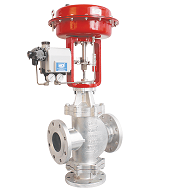Usage and Applications of Pneumatic Control Valve

Pneumatic control valves usage introduction:
A pneumatic control valve is one of the most widely used industrial process control devices in industries such as petroleum, chemical, electric power, and metallurgy. The pneumatic control valves is powered by compressed air, the actuator is the cylinder, and the valve is driven by accessories like the electric valve positioner, converter, solenoid valve, and retaining valve to achieve the switch or proportional adjustment, receiving the control signal of an industrial automation control system to adjust the flow, pressure, temperature and other process parameters of the pipeline medium.
A pneumatic control valves is a right-angle reverse layout. It can use with a valve positioner to adjust the share. V-shaped valve cores are most suitable for various adjustments. It has a high rate flow coefficient, a large adjustable ratio, and a sealing effect. It has a good, flexible conditioning function, is small, and can install vertically.
Working principle of pneumatic control valve:
Pneumatic control valves consist of an actuator and a conditioning mechanism. An actuator is the thrust component of the conditioning valve, which advances the conditioning mechanism according to the pressure of the control signal. An integral component of pneumatic control valves, the valve body regulates the flow of fluid directly by contacting the conditioning medium. Based on the flow characteristics of the medium, the structure can be classified as a pneumatic single-seat control valve, pneumatic sleeve control valve, pneumatic three-way control valve, pneumatic angle control valve, etc. The following describes the selection precautions.
What precautions should be taken when selecting pneumatic control valves?
Fundamentally, there is not much difference between the pneumatic control valves and the electric control valve, but the actuator is different. As opposed to the former, the latter requires only a power source, which is more convenient. The pneumatic control valves must be equipped with compressors and other equipment. Their advantages include explosion-proof functions, easy maintenance, and low failure rates. The scope of their application in the chemical, petrochemical, and other industries is much broader than that of electric control valves. Valve positioners are divided into mechanical and intelligent pneumatic valves. Intelligent pneumatic valves offer higher control accuracy than mechanical ones.

A valve body material can be chosen based on the different media. Commonly used materials include carbon steel, stainless steel 304 and 316, 316L, and others, as well as fluorine-lined control valves. There are also several pneumatic control valves that have special features: low-temperature control valves, high-temperature control valves, high-pressure control valves, small flow control valves, etc. In working conditions with a relatively small pressure difference, single-seat control valves are use. When the pressure difference is relatively large, you can choose sleeve control valves or double-seat control valves, because the leakage of a double-seat control valve is relatively large, so if the leakage must be very small, you should not choose double-seat control valves.
Three-way regulating valves combine two fluids into one or divide a fluid into two. In situations where there is a large pressure difference and cavitation or flashing is likely to occur, multi-stage cage control valves can select to reduce the pressure of the high-pressure fluid in stages to achieve stable control. It is important that users choose the pneumatic control valves according to their actual needs to achieve good results.
What can be done to solve the noise and erosion problems associated with pneumatic control valves?
- Mechanical vibration-For example, when the valve core of the pneumatic control valves moves horizontally in the sleeve, the gap between the valve core and sleeve can be as small as possible or a hard surface sleeve can use.
- The mechanical fluidity of the medium makes noise when it passes through a pipeline or pneumatic control valve. We will not elaborate further. Cavitation will also produce noise.
- The pneumatic control valve spool or other components have natural vibration frequencies. In this case, special castings or forgings can use to alter the spool’s characteristics, and if necessary other parts can replace. Spool type.
- When the cause is the instability of the spool, if the noise is cause by the fluctuating fluid pressure due to oscillating displacement, the damping factor of the regulator loop actuator is generally to blame. In the direction of spool displacement, adjust the damping coefficient or add damping facilities.
Operation of pneumatic control valves:
- Prior to using the pneumatic control valves, the system must calibrate jointly.
- When the pneumatic control valves are debug, all bypass valves should close and the valve should be within its normal operating range. Changing the position of the entire valve stem and compression spring is strictly prohibite.
- Raincheck, the first thing to do is to check whether the meter connection port is damp. Signs of water intrusion may be present.
Pneumatic control valves maintenance:
- To prolong the service life of the pneumatic control valves, perform liquidation and lubrication of various components.
- The pneumatic control valve should drain and lubricate on schedule, and the oil capacity of the oiler should be sufficient.
Aira Euro Automation is a leading Industrial Valve Manufacturer and supplier in India. We have full in-house production So we maintain our quality to date. We are reliable to our customers since 1990 and we have a huge chain of satisfied customers all around the world.
Also, read Parker Fittings Explained


